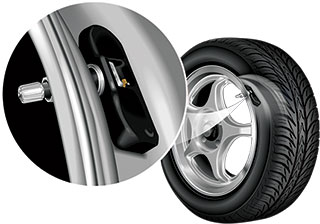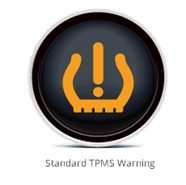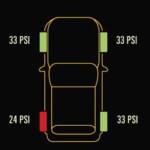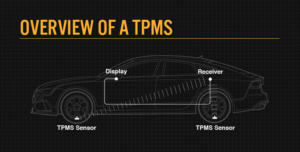Tire Pressure Monitoring System
As part of the effort to increase awareness of the need to maintain proper tire pressure, the U.S. government has taken steps to make it easier for drivers to be aware of potentially unsafe low pressure in their tires. As of the 2008 model year, the National Highway Traffic Safety Administration (NHTSA) now requires that all passenger cars and light trucks feature the Tire Pressure Monitoring System (TPMS). In conjunction with the new requirements, the Alliance of Automobile Manufacturers (AAM) has initiated a consumer safety campaign focusing on the importance of maintaining proper tire pressure.
TPMS is an automated system that monitors the air pressure in a vehicle tires. When air pressure in one on more tires drops to 25% or less the correct pressure, a warning indicator will alert the driver. TPMS typically delivers these alerts to the driver through one or two types of warning lights on the dashboard.
1. The first alert uses the official TPMS symbol, which is a cross-section of a tire with an exclamation mark in the center.
2. The second is a top-view graphic image of a car that indicates which tire or tires is low.
How TPMS Works
Tire pressure is monitored through one or two methods: direct or indirect. Direct TPMS monitors the actual air pressure inside each tire via a sensor mounted within the tire. Indirect TPMS measures tire pressure by monitoring the speed and rotation of each individual wheel. When a significant variation in speed and rotation is detected in one or more wheels when compared with others, it is often an indication of under-inflation. This information is then transmitted to the vehicle’s on-board computer and the driver is alerted.
While TPMS systems offer increased safety to drivers through low pressure warnings, they are not meant to be a substitute for proper tire pressure maintenance. Both the NHTSA and the AAM urge drivers to check their tire pressure at least once a month and always prior to a long trip. Be sure to read our article on the importance of correct air pressure as well for even more in-depth information.
Run Flat Tires: How They Work
Run flat tires are tires on which you can continue driving after a puncture so you can take time get to an auto shop or find a safe, level area to change your tire. You can’t drive on them indefinitely, though. Check the manufacturer’s specifications to find out how fast and how far you can drive on your run flat tires. Bridgestone run-flat tires will allow continued operation even after a loss of some or all inflation pressure for up to 50 miles (80 km) at a maximum speed up to 50 mph (80 km/h.)
There are two primary types of run flat tire systems: the self-supporting system and the support ring system. In most self-supporting run flat tire systems, the tire features reinforced sidewall construction that will continue supporting the vehicle in the event of air loss. This construction allows continued operation after the loss of air pressure up to the speed and distance specified by the manufacturer.
Since they continue performing even though they’re “flat,” all run flat tires, regardless of the specific system type, may only be used on a vehicle equipped with a Tire Pressure Monitoring System (TPMS). The TPMS alerts you as soon as one of your tires loses pressure. Without it, you might not know you were driving on an underinflated tire.
Benefits Of Run Flat Tires
You don’t have to change your tire in dangerous or uncomfortable conditions. This is perhaps the biggest benefit of run flat tires and is the one of the reasons why they were designed. With conventional tires, you have to replace a flat on the spot or have your car towed.
In a puncture situation, run flats are more stable than conventional tires. Since they’re made to support your vehicle even when they contain no air, run flat tires will help you maintain better control in a complete air loss situation than conventional tires.
As consumers continue rating safety high on the list of features they look for in a vehicle, the popularity of run flat tires is expected to grow. Since run flat tires work reliably with interconnected technologies like TPMS, it may only be a matter of time before they become the norm rather than the exception in new vehicles.















































































